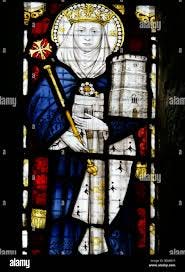The Mother Goddess and the Saint
The elusive St Madryn and her links with the Welsh mother goddess
As it is All Saints Day tomorrow, I thought I’d pay homage to St. Madryn, a Brythonic saint I came across while researching for my book Modron; Meeting the Celtic Mother Goddess. The Church, of course, stresses that there are no links between St Madryn (also known as St Materiana) and the goddess Modron/Matrona, but taking a closer look, I’m not sure that I’m entirely convinced of that…
St. Madryn is known predominantly in North Wales and Cornwall (coincidentally also areas associated with the goddess Modron and/or her son Mabon) where there are many churches dedicated to her along with a holy well or two. The parish church at Tintagel is dedicated to her, which immediately seems interesting when we consider that Tintagel is also frequently associated with Arthurian legend. Mabon, son of Modron, features in the earliest Arthurian sources, and in the Triads, Modron features as an Otherworldly woman who becomes the consort of King Urien of Rheged and mother of his warrior-hero son Owain. Both Urien and Owain show up in Arthurian tales as heroes, especially Owain, who fights for Arthur with his army of ravens. There are also mentions of an even more elusive St Mabon/Mabyn around the same Welsh and Cornish areas that we find St. Madryn. There is also some confusion about gender; there is a female St Mabon and a male St. Madron. All of these saints are so shadowy that scholars generally consider all or most of them to never have actually existed, which begs the question; who or what inspired their tales and names? Names clearly related to the Mother Goddess and her Divine Son?
Although the original mythos of Modron and Mabon is lost, we know it revolves around him being in some way stolen from her as a baby; a motif we see echoed throughout the Welsh tales of the Mabinogi. St. Madryn is, according to her legends in the medieval Bonedd y Sant, the granddaughter of Vortigern, a fifth century British warlord. According to the sixth century cleric Gildas, Vortigern teamed up with the Saxons to help him fight the Picts, and through this decision Britain fell to the Saxons. Vortigern fled to North Wales where he resided with Madryn, until the ongoing war led to St. Madryn having to flee to Cornwall with her baby son Ceidio, under threat of imprisonment and kidnap. Ceidio later became St. Cedwyn. Another mother and another endangered, special baby boy. Given the scholarly doubts that any of these saints were actual historical figures, it is more than tempting to wonder if the legends of St. Madryn were echoes of the original myths of Modron/Matrona, and many have concluded this is perhaps the case.
Vortigern himself may have been a historical figure, but he has also inspired his own legends. He was heavily associated with paganism, and one famous tale has him meeting the boy Merlin and nearly using him as a foundation sacrifice on the advice of his magicians/druids until Merlin shows him the druids are false, and the real problem is dragons under the foundations of the building.
Vortigern is generally depicted as a villain and so the Catholic church makes no mention of him in relation to St. Madryn but instead simply lists her as a ‘Cornish widow.’ The Anglican tradition however has her as the daughter of King Vortimer, and therefore the granddaughter of Vortigern, linking the Welsh and Cornish Madryns as the same figure. Madryn married Ynyr of Gwent, and in some tales the reason she and Ceidio have to flee is because it is Ynyr who is under attack, rather than her grandfather Vortigern. As with most of our early medieval sources, much is tangled and confused in the original tales. In other versions Madryn is the mother of Caradoc, another Welsh hero, or the grandmother of the Scottish St. Mungo. Mabon, son of Modron, is also associated with the Scottish borderlands, where there was an Iron Age cult to the earlier version of him, the god Maponus.
Madryn is also sometimes listed as having a daughter, Tegiwg, who in some tales is then confused with St Winifred. St Winifred is also considered to have pagan echoes; her tales involve talking severed heads and holy springs magically bubbling up from the ground, both common motifs in Celtic myth and legend.
Madryn herself later became known as St Materiana and is still honoured and beloved in Cornwall under that name. She has her own hymn in the Anglican church, which addresses her as ‘holy Mother’ and goes on;
Over thy people, still preside
Over thy household
Clothed in scarlet vesture
Of love and holy pride
The children rise and call thee blessed
Gathered around thee at thy side
I don't know about you, but this has clear Mother Goddess echoes to me….




Loved how you managed to thread your way through such a tangle!